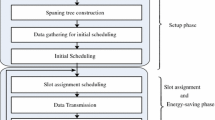Abstract
This paper describes a power-efficient distributed TDMA slot scheduling algorithm which the slot allocation priority is controlled by distance measurement information in details. In our former proposed scheme, L-DRAND+, an extension of Lamport’s bakery algorithm for prioritized slot allocation based on the distance measurement information between nodes and a packet-based transmission power control had been applied. In this paper, we propose its enhanced scheme with a weighted rule control and state machines refinements of L-DRAND+, named L-DRAND++. This aims at the achievement of media access control methods which can construct a local wireless network practically by limiting the scope, and eliminate the redundant power consumption in the network. The proposed scheme can be shown as a possible replacement of DRAND algorithm for Z-MAC scheme in a distance-measurement-oriented manner. In addition, to evaluate the ordered node sequence determined by the algorithm, node sequence metric is proposed. By using the metric, we can evaluate protocol behaviors according to the environmental situation around the node.









Similar content being viewed by others
Notes
In Z-MAC, DRAND phase has been designed separately from the beginning, assuming the position of each node is fixed statically.
Simulation parameters are configured according to the 914 MHz Lucent Wavelan DSSS radio Interface.
Instead of TwoRayGround model, Freespace is practically used to calculate the transmission power to be adjusted because the inter-node distance will not exceed the crossover distance in this case.
The slot allocation process was regarded as a discrete event, it should be started when after a topological change would be detected. Therefore, we handle only the genuine processing time itself, without SLEEP in this work.
References
Boukerche, A. (2009). Algorithms and protocols for wireless sensor networks. New York: Wiley.
Sato, K., & Sakata, S. (Dec 2012). A distributed TDMA scheduling algorithm with distance-measurement-based power control for sensor networks. IEICE Transactions on Information and Systems, E95-D(12), 2879–2887.
Rhee, I., Warrier, A., Min, J., & Xu, L. (2006). DRAND: Distributed randomized TDMA scheduling for wireless ad-hoc networks. In Proceedings of the 7th ACM international symposium on mobile ad hoc networking and computing, Florence, pp. 190–201.
Rhee, I., Warrier, A., Aia, M., & Min, J. (2005). Z-MAC: A hybrid MAC for wireless sensor networks. In Proceedings of the 3rd international conference on embedded networked sensor systems (SenSys ’05), pp. 90–101.
Heinzelman, W. R., Chandrakasan, A., & Balakrishnan, H. (2000). Energy-effcient communication protocol for wireless microsensor networks. In Proceedings of the Hawaii international conference on system sciences (HICSS), Maui, Hawaii.
Mahapatro, A., & Khilar, P. M. (2013). Mobility adaptive unequal cluster-based routing protocol in wireless sensor networks. International Journal of Sensor Networks, 14(2), 65–81.
Bryan, K. L., Ren, T., DiPippo, L., Henry, T., & Fay-Wolfe, V. (2007). Towards optimal TDMA frame size in wireless sensor networks, in technical report. Kingston, USA: Department of Computer Science and Statistics: University of Rhode Island.
Rhee, I., Warrier, A., & Xu, L. (2004). Randomized dining philosophers to TDMA scheduling in wireless sensor networks, in technical report. Raleigh, NC: Computer Science Department, North California State University.
Lamport, L. (1974). A new solution of Dijkstra’s concurrent programming problem. Communications of the ACM, 17(8), 453–455.
Sato, K., & Sakata, S. (2012). Lamport’s bakery algorithm extension for distance-oriented TDMA scheduling with priority control on sensor networks. In Multimedia, distributed, cooperative, and mobile symposium (DICOMO2012), pp. 1802–1809.
The Network Simulator—ns-2: http://www.isi.edu/nsnam/ns/.
Sato, K., & Sakata, S. (July 2010). ManueverXML:Distance-Measurement based operation event description model and user interaction interpretation. In Proceedings of the 10th annual symposium on application and the internet (SAINT2010) WS-1(EUCASS).
Author information
Authors and Affiliations
Corresponding author
Rights and permissions
About this article
Cite this article
Sato, K., Sakata, S. A Power-Efficient Distributed TDMA Scheduling Algorithm with Distance-Measurement for Wireless Sensor Networks. Wireless Pers Commun 75, 1511–1528 (2014). https://doi.org/10.1007/s11277-013-1435-y
Published:
Issue Date:
DOI: https://doi.org/10.1007/s11277-013-1435-y




